#the palestinian 1977
Text
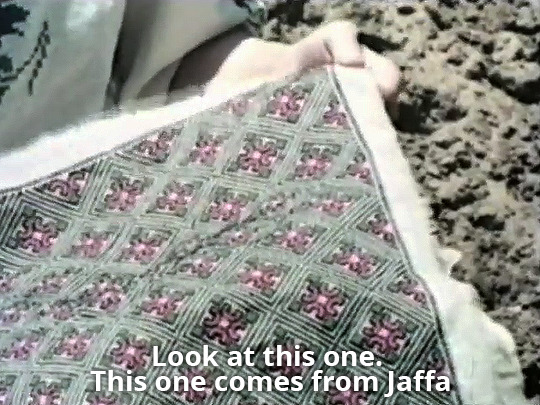
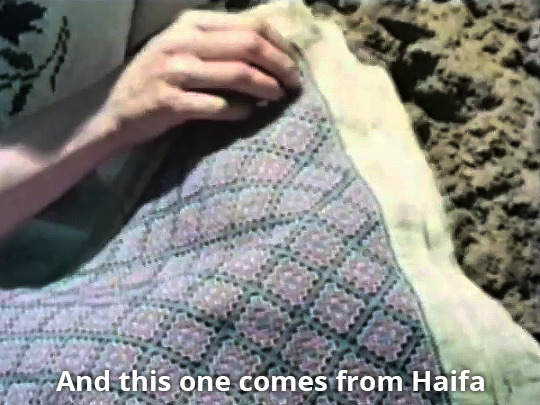
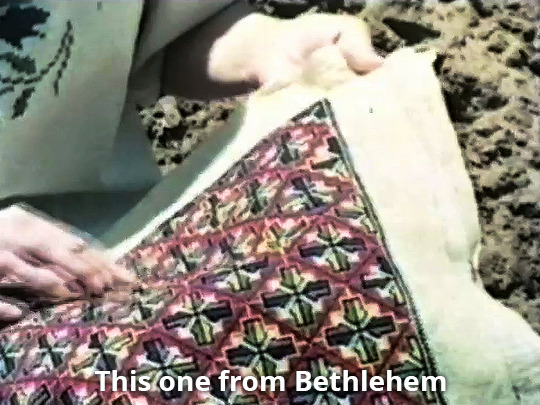
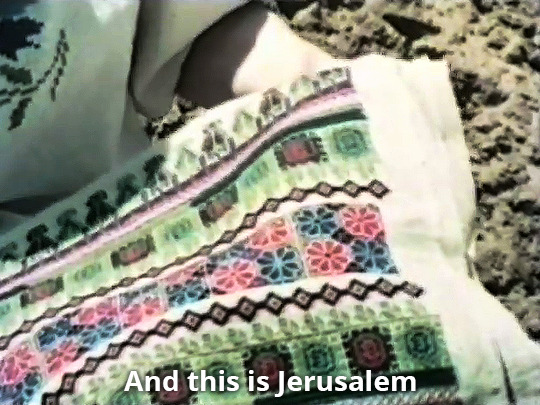
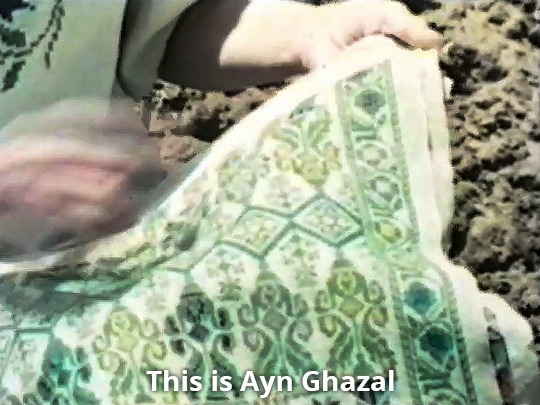
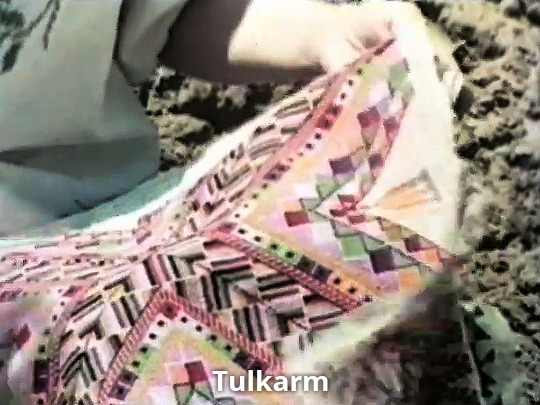
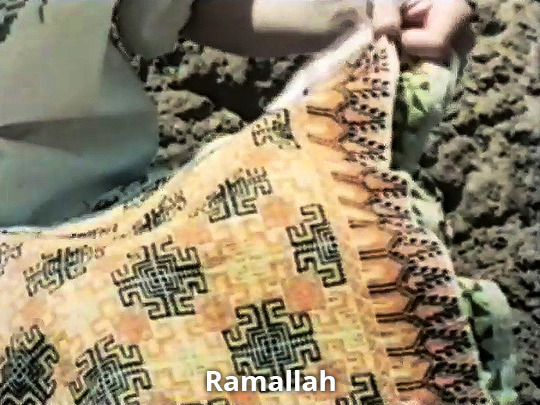

The Palestinian (1977)
#the palestinian 1977#vanessa redgrave#gaza#ramallah#tulkarm#ayn ghazal#jerusalem#bethlehem#haifa#jaffa#documentary#screencaps#post#history#tatreez#artistry#jerusalem and tulkarem my favess#textiles#art
28K notes
·
View notes
Text

[ID: A decorative orange ceramic plate with a pyramid of green herbs and sesame seeds, topped with deep red sumac and more sesame seeds. End ID]
زعتر فلسطيني / Za'tar falastinia (Palestinian spice blend)
Za'tar (زَعْتَر; also transliterated "za'atar," "zaatar" and "zatar") is the name of a family of culinary herbs; it is also the name of a group of spice blends made by mixing these herbs with varying amounts of olive oil, sumac, salt, roasted sesame seeds, and other spices. Palestinian versions of za'tar often include caraway, aniseed, and roasted wheat alongside generous portions of sumac and sesame seeds. The resulting blend is bold, zesty, and aromatic, with a hint of floral sourness from the sumac, and notes of licorice and anise.
Za'tar is considered by Palestinians to have particular national, political, and personal importance, and exists as a symbol of both Israeli oppression and Palestinian home-making and resistance. Its major components, olive oil and wild thyme, are targeted by the settler state in large part due to their importance to ecology, identity, and trade in Palestine—settlers burn and raze Palestinian farmers' olive trees by the thousands each year. A 1977 Israeli law forbade the harvesting of wild herbs within its claimed borders, with violators of the law risking fines and confiscation, injury, and even death from shootings or land mines; in 2006, za'tar was further restricted, such that even its possession in the West Bank was met with confiscation and fines.
Despite the blanket ban on harvesting wild herbs (none of which are endangered), Arabs are the only ones to be charged and fined for the crime. Samir Naamnih calls the ban an attempt to "starve us out," given that foraging is a major source of food for many Palestinians, and that picking and selling herbs is often the sole form of income for impoverished families. Meanwhile, Israeli farmers have domesticated and farmed za'tar on expropriated Palestinian land, selling it (both the herb and the spice mixture) back to Palestinians, and later marketing it abroad as an "Israeli" blend; they thus profit from the ban on wild harvesting of the herb. This farming model, as well as the double standard regarding harvesting, refer back to an idea that Arabs are a primitive people unfit to own the land, because they did not cultivate or develop it as the settlers did (i.e., did not attempt to recreate a European landscape or European models of agriculture); colonizing and settling the land are cast as justified, and even righteous.
The importance of the ban on foraging goes beyond the economic. Raya Ziada, founder of an acroecology nonprofit based in Ramallah, noted in 2019 that "taking away access to [wild herbs] doesn't just debilitate our economy and compromise what we eat. It's symbolic." Za'tar serves variously as a symbol of Palestinians' connection to the land and to nature; of Israeli colonial dispossession and theft; of the Palestinian home ("It’s a sign of a Palestinian home that has za’tar in it"); and of resistance to the colonial regime, as many Palestinians have continued to forage herbs such as za'tar and akkoub in the decades since the 1977 ban. Resistance to oppression will continue as long as there is oppression.
Palestine Action has called for bail fund donations to aid in their storming, occupying, shutting down, and dismantling of factories and offices owned by Israeli arms manufacturer Elbit Systems. Also contact your representatives in the USA, UK, and Canada.
Ingredients:
Za'tar (Origanum syriacum), 250g once dried (about 4 cups packed)
250g (1 2/3 cup) sesame seeds
170g (3/4 cup) Levantine sumac berries, or ground sumac (Rhus coriaria)
100g (1/2 cup) wheat berries (optional)
2 Tbsp olive oil
1 Tbsp aniseed (optional)
1/2 Tbsp caraway seeds (optional)
Levantine wild thyme (also known as Bible hyssop, Syrian oregano, and Lebanese oregano) may be purchased dried online. You may also be able to find some dried at a halal grocery store, where it will be labelled "زعتر" (za'tar) and "thym," "thyme," or "oregano." Check to make sure that what you're buying is just the herb and not the prepared mixture, which is also called "زعتر." Also ensure that what you're buying is not a product of Israel.
If you don't have access to Levantine thyme, Greek or Turkish oregano are good substitutes.
Wheat berries are the wheat kernel that is ground to produce flour. They may be available sold as "wheat berries" at a speciality health foods store. They may be omitted, or replaced with pre-ground whole wheat flour.
Instructions:
1. Harvest wild thyme and remove the stems from the leaves. Wash the leaves in a large bowl of water and pat dry; leave in a single layer in the sun for four days or so, until brittle. Skip this step if using pre-dried herbs.
2. Crumble leaves by rubbing them between the palms of your hands until they are very fine. Pass through a sieve or flour sifter into a large bowl, re-crumbling any leaves that are too coarse to get through.
Crumbling between the hands is an older method. You may also use a blender or food processor to grind the leaves.
3. Mix the sifted thyme with a drizzle of olive oil and work it between your hands until incorporated.
4. Briefly toast sumac berries, caraway seeds, and aniseed in a dry skillet over medium heat, then grind them to a fine powder in a mortar and pestle or a spice mill.
5. Toast sesame seeds in a dry skillet over medium heat, stirring constantly, until deeply golden brown.
6. (Optional) In a dry skillet on medium-low, toast wheat berries, stirring constantly, until they are deeply golden brown. Grind to a fine powder in a spice mill. If using ground flour, toast on low, stirring constantly, until browned.

Some people in the Levant bring their wheat to a local mill to be ground after toasting, as it produces a finer and more consistent texture.
7. Mix all ingredients together and work between your hands to incorporate.
Store za'tar in an airtight jar at room temperature. Mix with olive oil and use as a dipping sauce with bread.
2K notes
·
View notes
Text
every time i learn about another legislative attempt by isr*el to eradicate palestine, palestinians, and palestinian culture it just sounds more ghoulishly evil- like that in 1977 israel made foraging for wild za'atar a punishable offence. not only za'atar but akkoub and wild sage as well (please watch foragers by jumana manna!). or making it illegal for palestinians to collect rainwater. the 800,000 olive trees that have been destroyed by israel since 1967. the colonizer's playbook, as if you can legislate a people out of existence by cutting them off from the earth, the dirt, the soil, the water, the fundamental parts of humanity. genocide and this type of ecological terrorism walk hand in hand, as if the earth doesn't yearn like a heart.
#i won't comment on how despairingly similar this is to attempts by us/canadian governments to cut off indigenous people from their#traditional foraging and hunting grounds but know im thinking it. lol#free palestine#p
2K notes
·
View notes
Text
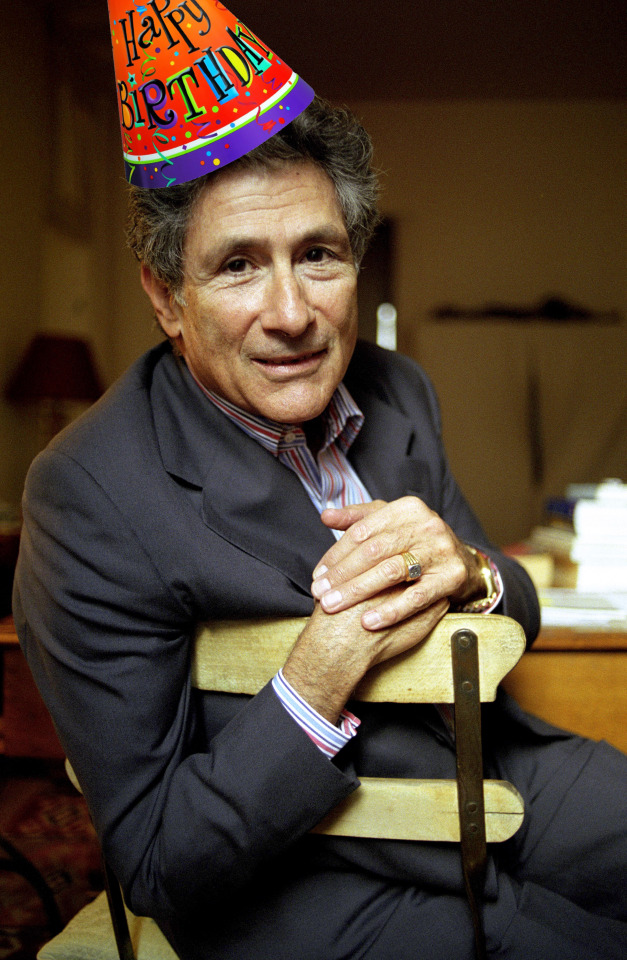
Happy birthday, Edward Said! (November 1, 1935)
A highly influential Palestinian academic, author, and activist, Edward Said was born in Jerusalem to Christian Palestinian parents. After receiving his education, Said began a teaching career at Columbia University, and would also teach at institutions including Stanford and Yale. A prolific academic, Said also contributed editorially to publications including the Arab Studies Quarterly and as the president of the Modern Language Association. Said is best known as a cultural critic through such books as Orientalism and Culture and Imperialism, the former of which, his best-known work, laid out his critique of European and American perceptions of "the East," and those perceptions' link with imperialism and colonialism. He also advocated for the Arab and Palestinian perspective on the issue of Palestine, and from 1977 to 1991 Said served on the Palestinian National Council, where he critiqued the Oslo Accords for not establishing an independent State of Palestine. He died in 2003 in New York City.
"Every single empire in its official discourse has said that it is not like all the others, that its circumstances are special, that it has a mission to enlighten, civilize, bring order and democracy, and that it uses force only as a last resort. And, sadder still, there always is a chorus of willing intellectuals to say calming words about benign or altruistic empires, as if one shouldn't trust the evidence of one's eyes watching the destruction and the misery and death brought by the latest mission civilizatrice."
2K notes
·
View notes
Text

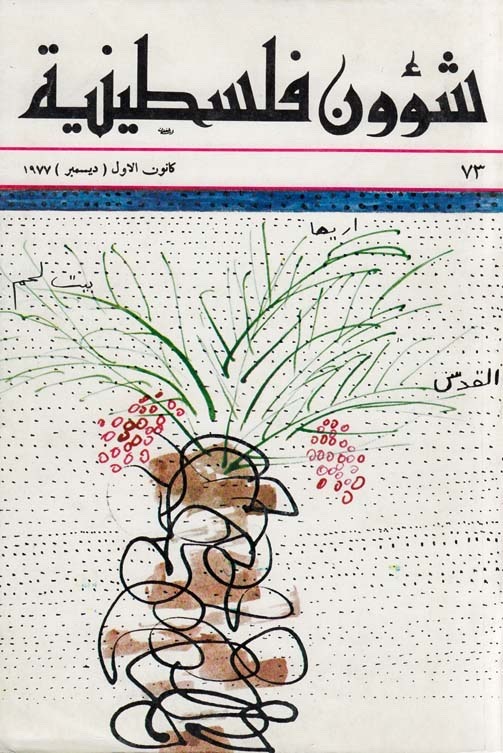
Etel Adnan’s 1977 covers for Palestinian Affairs magazine, issues 192 and 193
2K notes
·
View notes
Text
JIMMY CARTER: ISRAEL TICKS APARTHEID BOXES
In this 2007 clip from a @democracynow interview, former US President Jimmy Carter (1977-81) highlighted how the state of Israel is not only like the South African apartheid state but more restrictive.
In 2022, Amnesty International declared Israel an apartheid state in a 280-page report that documented how Tel Aviv controls Palestinian territories and people. Other groups, including Human Rights Watch and Israeli human rights organisation B’Tselem, came to the same conclusion a year prior.
Since the 7 October escalation in the 75-year Palestine-Israel conflict, Israel has killed nearly 32,000 Palestinians and injured more than 73,000 people. Because Israel controls movement into and out of the Palestinian territories, it has blocked the entry of foreign aid and Palestinians’ attempts to flee Israel’s military attacks.
However, the United States has provided the most foreign aid to Israel than to any other country since 1948. That funding continued during Carter’s term.
#israel is an apartheid state#israeli apartheid#palestine#gaza#free palestine#israel#jerusalem#i stand with palestine#فلسطين#free gaza#israel is a terrorist state#israeli war crimes#israelis are terrorists#israelis are war criminals#israeli terrorism#israel is committing genocide#israel is a war criminal#israel is evil#jimmy carter
411 notes
·
View notes
Text
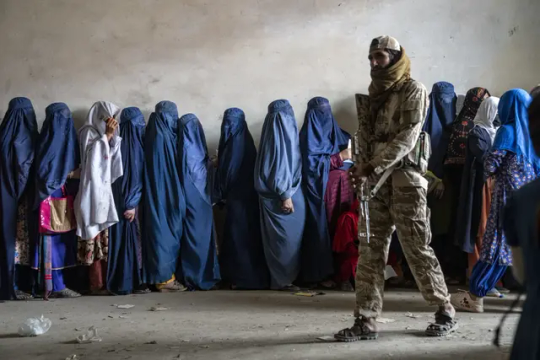
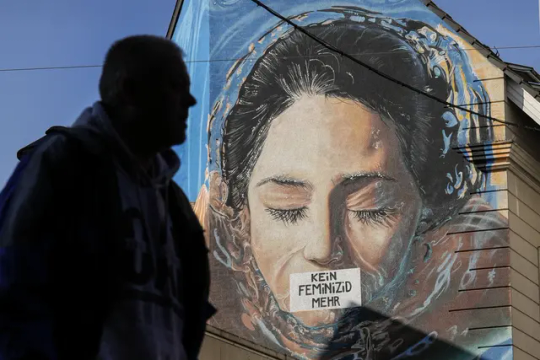
By EDITH M. LEDERER Updated 9:11 PM PST, March 8, 2024
UNITED NATIONS (AP) —
Legal equality for women could take centuries as the fight for gender equality is becoming an uphill struggle against widespread discrimination and gross human human rights abuses, the United Nations chief said on International Women’s Day.
Secretary-General Antonio Guterres told a packed U.N. commemoration Friday that “a global backlash against women’s rights is threatening, and in some cases reversing, progress in developing and developed countries alike.”
The most egregious example is in Afghanistan, he said, where the ruling Taliban have barred girls from education beyond sixth grade, from employment outside the home, and from most public spaces, including parks and hair salons.
At the current rate of change, legal equality for women could take 300 years to achieve and so could ending child marriage, he said.
Guterres pointed to “a persistent epidemic of gender-based violence,” a gender pay gap of at least 20%, and the underrepresentation of women in politics. He cited September’s annual gathering of world leaders at the U.N. General Assembly, where just 12% of the speakers were women.
“And the global crises we face are hitting women and girls hardest — from poverty and hunger to climate disasters, war and terror,” the secretary-general said.
In the past year, Guterres said, there have been testimonies of rape and trafficking in Sudan, and in Gaza women women and children account for a majority of the more than 30,000 Palestinians reported killed in the Israeli-Hamas conflict, according to the Gaza Ministry of Health.
He cited a report Monday by the U.N. envoy focusing on sexual violence in conflict that concluded there are “reasonable grounds” to believe Hamas committed rape, “sexualized torture” and other cruel and inhumane treatment of women during its surprise attack in southern Israel on Oct. 7. He also pointed to reports of sexual violence against Palestinians detained by Israel.
International Women’s Day grew out of labor movements in North America and across Europe at the turn of the 20th century and was officially recognized by the United Nations in 1977. This year’s theme is investing in women and girls to accelerate progress toward equality.
Roza Otunbayeva, the head of the U.N. political mission in Afghanistan, told the Security Council on Wednesday that what is happening in that country “is precisely the opposite” of investing in women and girls.
There is “a deliberate disinvestment that is both harsh and unsustainable,” she said, saying the Taliban’s crackdown on women and girls has caused “immense harm to mental and physical health, and livelihoods.”
Recent detentions of women and girls for alleged violations of the Islamic dress code “were a further violation of human rights, and carry enormous stigma for women and girls,” she said. It has had “a chilling effect among the wider female population, many of whom are now afraid to move in public,” she said.
Otunbayeva again called on the Taliban to reverse the restrictions, warning that the longer they remain, “the more damage will be done.”
Sima Bahous, the head of UN Women, the agency promoting gender equality and women’s rights, told the commemoration that International Women’s Day “sees a world hobbled by confrontation, fragmentation, fear and most of all inequality.”
“Poverty has a female face,” she said. “One in every 10 women in the world lives in extreme poverty.”
Men not only dominate the halls of power but they “own $105 trillion more wealth than women,” she said.
Bahous said well-resourced and powerful opponents of gender equality are pushing back against progress. The opposition is being fueled by anti-gender movements, foes of democracy, restricted civic space and “a breakdown of trust between people and state, and regressive policies and legislation,” she said.
[Click on the link to continue reading]
#women's rights#femicide#taliban#women's oppression#international women's day#global feminism#feminism
292 notes
·
View notes
Text
Hi, I’m a lawyer. Do want to know what is really meant by a “#proportionate response” under international law? Then read on - and feel free to ask questions!
Under International Humanitarian Law, #proportionality requires that any degree of damage (up to and including death) to #civilians not be “excessive” in relation to the “military advantage anticipated from a strike against a military target.”
We are going to break that down, so everyone understands what exactly that means.
However, first, you should be aware that it is a misnomer that anytime #Palestinian civilians die after an #Israeli strike, it is automatically evidence of an Israeli war crime. This is completely false - the law does not work that way.
Simply, and unfortunately, the international rules of law recognize that civilians are often killed during war; and, most of the time, those deaths are actually not indicative of a war crime.
Instead, the legal test for “proportionality” requires that each individual strike be looked at with a particular balancing analysis.
First, here is a hard and fast rule: the strike must be intended to target a military objective; it is, therefore, an unlawful war crime to strike with the intent of targeting civilians without any military objective whatsoever.
Now, let’s get a little technical while still keeping it simple.
Under the First Additional Protocol to the Geneva Conventions of 1977 at both Article 51(5)(b) and Article 52(2), we know that when #Hamas uses its own population (or Israeli #hostages) as #humanshields - either by using them to shield themselves or to shield their weapons depots - Hamas has, under international law, turned civilians targets into military targets.
That means that when Hamas places weapons caches in and under schools, hospitals, mosques, etc., Hamas has made each of those places legitimate military targets.
So, it has been well-known for many years that Hamas purposefully placed its headquarters underground beneath the al-Shifa Hospital. In doing so, international law holds that the hospital is no longer just a civilian target, it is a legitimate military target.
That does not necessarily give the IDF carte blanche to attack hospitals, schools, mosques, etc.; however, it does mean that an IDF attack on a civilian target that has been made into a military target by Hamas’ use of human shields is not per se illegal under international law.
Instead, such a strike (as is the case with any strike conducted by a military like the IDF), must be analyzed through a balancing test.
One part of this balancing test performed by Israel before each strike is to determine whether the human shields in question are being used voluntarily or involuntarily.
If the human shields are being used voluntarily - meaning the human shields are there protecting Hamas and its weapons of their own volition - then the target remains a completely legitimate military target.
If the human shields are being used involuntarily - meaning Hamas is forcing people to act as human shields to protect themselves and/or their weapons - then the IDF must go back to the balancing test to determine whether the anticipated military advantage of a successful strike would outweigh the reasonably anticipated loss of civilian life.
Importantly, the IDF rules state that if it cannot determine whether a human shield is being used voluntarily or involuntarily, it must presume the civilian is being used against his or her own will and treat the civilians as an involuntary participant.
Assuming that there is a military target & that there may be human shields that are there involuntarily, the next step in the proportionality analysis for each individual strike (remember, proportionality is determined on a strike-by-strike basis, and not as the accumulation of strikes over time) is to try to determine the likely amount of damage to civilian persons and/or property as a result of the strike.
In other words, under international law, Israel must be able to give a sort of “value” to the anticipated impact on civilians (including potential civilian deaths). Simply, a smaller number of anticipated civilian casualties may make the strike proportionate if there is a significant military advantage to be gained by conducting the strike.
However, if Israel determines that the anticipated impact of a strike may cause many civilian casualties, it must make the difficult determination of whether the anticipated military advantage is so significant that it warrants carrying out the strike anyway.
So, if Hamas has a weapons depot underneath a house with two civilians inside, and that house has been used to fire 500 rockets at Israeli civilians, and it is reasonably expected that there are hundreds more rockets under that house, Israel can almost certainly carry out the strike within the confines of international law.
If that same house, however, had 10 families living inside, including many children, it could - and likely would - tip the scales of the proportionality balancing test toward Israel not being permitted to carry out the strike, even though the house has been used to attack Israeli civilians and can be expected to continue to be used to carry out attacks against Israeli civilians.
Now, that balancing test can always change. If that same house is being used to fire long-range, precision-guided missiles at Israel’s major population centers in places like #TelAviv (effectively putting millions of Israeli civilians in danger), the balancing test may tip back in favor of Israel being legally permitted to carry out the strike.
This all suggests the third and final step in the proportionality balancing test: the #IDF must determine and place a “value” on the anticipated military advantage that would be gained if it were to carry out a particular strike.
An attack on Hamas leadership and/or its weapons manufacturers would be considered a high value target. An attack on a single Hamas member who has no special skill, would be a much lower value military target.
Similarly, an attack on a small cache of mortars would have less military value that an attack on a large cache of advanced rockets that can reach large Israeli civilian population centers.
Once the @IDF determines the anticipated “value” of the likely effect on civilian persons and property and the anticipated “value” of the likely military advantage to be gained if the strike is carried out, the balancing test can be performed, and a certain amount of judgment must go into the determination of whether that strike would or would not be “proportionate.”
Importantly, this decision is so vital that the IDF does not simply permit a single solder on the ground with his or her hand on the proverbial (or actual) “trigger” to make that determination.
In fact, the decision of whether a strike is proportionate is not even left up to IDF officers. It’s not even left up to IDF Generals.
Instead, before any IDF strike can take place, IDF Guidelines provide that the proportionality balancing test must be presented to and analyzed by IDF military lawyers who then determine whether the strike is legally permissible as “proportionate” under international law and the rules of war.
And these IDF military lawyers are not mere patsies or people who simply “rubber stamp” what the IDF requests.
In fact, the IDF’s military lawyers work entirely independently of the IDF. They are outside of the chain of command and do not answer to anyone in the IDF, including a General (for example).
Plus, every IDF military lawyer knows he or she may very well be held to account if he or she makes a wrong decision based on the evidence available at the time.
Furthermore, sometimes the decisions to be made while balancing the likely military advantage against the likely civilian casualties can be so difficult that the legality of the strike is first brought to the Israeli Supreme Court for instant review.
Another important concept: the comparison of civilian body counts of #Israelis versus #Palestinians (to the extent those numbers can be trusted since they come directly from Hamas-only) is not relevant to a proportionality analysis. Each strike must be viewed individually to determine proportionality. It is not a test of the cumulative nature of the strikes.
Also, by simply comparing body counts, it does not factor in how many people killed were actually #HamasTerrorists, how many were Hamas collaborators there voluntarily, and it does not consider what military advantage was gained by Israel carrying out any individual strike.
As Israel is now in the process of seeking to secure the military advantage of preventing Hamas from having the capacity to carry out repeated attacks of the kind and nature seen on October 7th, Israel is permitted to act proportionately insofar as necessary to achieve that military objective (the elimination of Hamas and/or its ability to make war).
One more important fact people do not know, but that they should know: according to UN statistics of global conflict, the average civilian to combatant killed ratio is a rather appalling nine civilians killed for every one combatant killed.
That’s why civilian body counts in and of themselves are never indicative of a war crime. Each individual strike has to be analyzed, and unfortunately civilians always suffer disproportionately in wars.
In fact, while Israel is routinely criticized for any of its strikes that kill civilians, you may be surprised to know that Israel’s civilian to combatant ratio is routinely much lower than the nine to one average.
In the very last operation carried out by the IDF prior to October 7 (in Jenin), 0.6 civilians were killed for every one combatant killed.
In that conflict, not only were the IDF’s ratio numbers nowhere near the nine to one international average, but the IDF actually managed to kill more combatants than civilians - something that is extremely rare.
In truth, Israel is targeted by accusations of war crimes almost immediately by the media, by politicians, and by the UN General Assembly despite the fact that those accusations are near 100% of the time based neither in fact nor in law.
Since a proportionality balancing test must be used to determine whether a single specific Israeli strike falls within the confines of international law, someone providing an analysis must have all of the facts Israel considered before carrying out that strike as to the anticipated impact on civilians and the anticipated military advantage. Obviously, anyone who is making a snap judgment critical of Israel could not possibly have that information.
Understand then, that when you see talking heads accusing Israel of “war crimes” immediately after and/or during Israeli strikes, that is not an actual legal analysis under international law of what constitutes a war crime.
Much more likely, what you are witnessing is part of Hamas’ ongoing psychological and propaganda warfare campaign of demonizing and delegitimizing the State of Israel in the eyes of public opinion.
#Hamas_is_ISIS #HamasisISIS #HamasISIS #HamasMonsters #October7massacre
#israel#israel hamas war#hamas#military#war crimes#war crime#war law#law#palestine#gaza#free palestine from hamas#free palestine
555 notes
·
View notes
Text
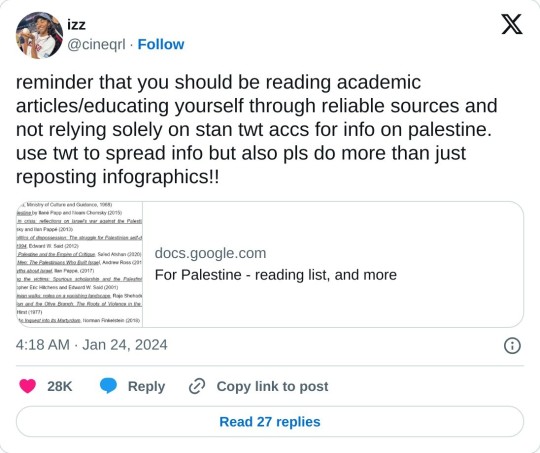
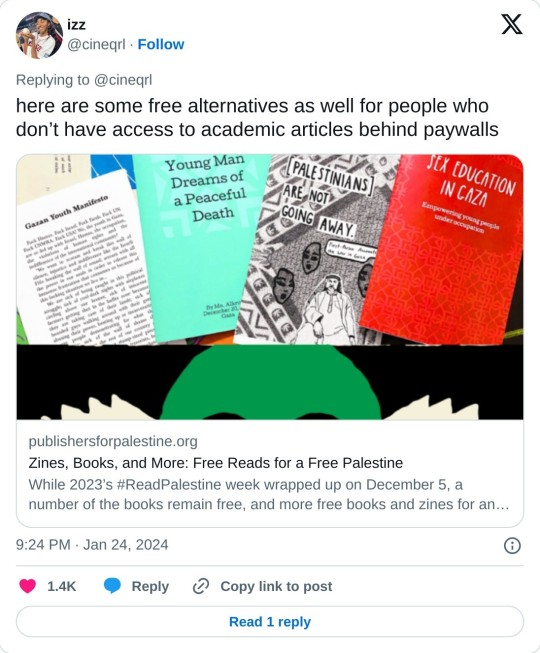
A copy of the first reading list, if you dislike clicking on Google docs links:
The liberal news media is working overtime to silence Palestinian voices. As we sit thousands of miles away, witnessing the massacre through social media, the least we can do is educate ourselves and work to educate others. Apartheid threatens all of us, and just to reiterate, anti-Zionism ≠ antisemitism.
Academic Works, Poetry and Memoirs
The Revolution of 1936-1939 in Palestine: Background, Details, and Analysis, Ghassan Kanafani (1972)
Palestinians: From Peasants to Revolutionaries, Rosemary Sayegh (1979)
Popular Resistance in Palestine: A History of Hope and Empowerment, Mazin Qumsiyeh (2011)
My Life in the PLO: The Inside Story of the Palestinian Struggle, Shafiq al-Hout and Jean Said Makdisi (2019)
My People Shall Live, Leila Khaled (1971)
Poetry of Resistance in Occupied Palestine, translated by Sulafa Hijjawi (Baghdad, Ministry of Culture and Guidance, 1968)
On Palestine by Ilan Pappé and Noam Chomsky (2015)
Gaza in Crisis: Reflections on the US-Israeli War Against the Palestinians, Noam Chomsky and Ilan Pappé (2013)
The Politics of Dispossession: The Struggle for Palestinian Self-Determination, 1969-1994, Edward W. Said (2012)
Queer Palestine and the Empire of Critique, Sa’ed Atshan (2020)
Stone Men: The Palestinians Who Built Israel, Andrew Ross (2019)
Ten Myths About Israel, Ilan Pappé (2017)
Blaming the Victims: Spurious Scholarship and the Palestinian Question, Christopher Eric Hitchens and Edward W. Said (2001)
Palestinian Walks: Notes on a Vanishing Landscape, Raja Shehadeh (2010)
The Gun and the Olive Branch: The Roots of Violence in the Middle East, David Hirst (1977)
Gaza: An Inquest into Its Martyrdom, Norman Finkelstein (2018)
Fateful Triangle: The United States, Israel and the Palestinians, Noam Chomsky (1983)
Israel and Palestine: Reappraisals, Revisions, Refutations, Avi Shlaim (2010)
Politicide: Ariel Sharon’s War Against the Palestinians, Baruch Kimmerling (2006)
The Holocaust Industry: Reflections on the Exploitation of Jewish Suffering, Norman G. Finkelstein (2015)
Light in Gaza: Writings Born of Fire, Jehad Abusalim (2022)
Nakba: Palestine, 1948, and the Claims of Memory, Ahmad H. Sa’di and Lila Abu-Lughod (2007)
Peace and its discontents: Essays on Palestine in the Middle East peace process, Edward W. Said (2012)
Three Poems by Yahya Hassan
Articles, Papers & Essays
“Palestinian history doesn’t start with the Nakba” by PYM (May, 2023)
“What the Uprising Means,” Salim Tamari (1988)
“The Palestinians’ inalienable right to resist,” Louis Allday (2021)
“Liberating a Palestinian Novel from Israeli Prison,” Danya Al-Saleh and Samar Al-Saleh (2023)
Women, War, and Peace: Reflections from the Intifada, Nahla Abdo (2002)
“A Place Without a Door” and “Uncle Give me a Cigarette”—Two Essays by Palestinian Political Prisoner, Walid Daqqah (2023)
“Live Like a Porcupine, Fight Like a Flea,” A Translation of an Article by Basel Al-Araj
Films & Video Essays
Fedayin: Georges Abdallah’s Fight (2021)
Naila and the Uprising (2017)
Off Frame AKA Revolution Until Victory (2015)
Tell Your Tale Little Bird (1993)
The Time That Remains (2009)
“The Present” (short film) (2020)
“How Palestinians were expelled from their homes”
Louis Theroux: The Ultra Zionists (2011)
Born in Gaza (2014)
5 Broken Cameras (2011)
Little Palestine: Diary of a Siege (2021)
Al-Nakba: The Palestinian catastrophe - Episode 1 | Featured Documentary
Organisations to donate to
Palestine Red Crescent Society - https://www.palestinercs.org/en
Anera - https://support.anera.org/a/palestine-emergency
Palestinian American Medical Association - https://palestinian-ama.networkforgood.com/projects/206145-gaza-medical-supplies-oct-2023
You First Gaza - https://donate.gazayoufirst.org/
MAP - Medical Aid for Palestinians - https://www.map.org.uk/donate/donate
United Nations Relief and Works Agency - https://donate.unrwa.org/-landing-page/en_EN
Palestine Children’s Relief Fund - https://www.pcrf.net/
Doctors Without Borders - https://www.doctorswithoutborders.org/what-we-do/where-we-work/palestine
AP Fact Check
https://apnews.com/article/israel-hamas-gaza-misinformation-fact-check-e58f9ab8696309305c3ea2bfb269258e
This list is not exhaustive in any way, and is a summary of various sources on the Internet. Please engage with more ethical, unbiased sources, including Decolonize Palestine and this list compiled by the Palestinian Youth Movement.
318 notes
·
View notes
Text
One of the worst justifications for the Hamas massacre that I have seen is the idea that the Palestinians had been suffering for 75 years, and such a long period of suffering is what made them be so brutal towards the civilians in the Jewish state.
This ignores, of course, brutal massacres that happened way before decades had passed since Israel's Independence War (which the Arabs started and lost). One such massacre took place on March 17, 1954. Less than five years after the end of that war. The other day, we commemorated 70 years since it happened. In order to remember, one reporter interviewed a survivor.
The entire piece was too long for Tumblr even after I downgraded the vid quality, so I edited out parts that were less relevant to understanding the massacre, and the story of this one child survivor.
Translator's notes:
-> Chaim'keh is the affectionate diminutive for Chaim, Mira'leh is the same for Miri.
-> In another interview, Miri shared that the reason her dad was taking them to Eilat, was because he wanted them to move to Israel's most southern city, meaning he felt Chana and the kids should see it.
-> This is the Ma'ale Akrabim road, you can see how serpentine it is, and the bus was driving uphill, explaining why it had to slow down so much that it became a perfect target for the terrorists.

-> 'Confirmation of killing' is a military term, referring to any situation where after shots have been fired at someone, the shooter comes closer and shoots (or wounds) again, from a much smaller distance, to make sure the victim is indeed dead, and not just wounded.
-> Chaim was shot in the head point blank, but somehow he technically survived. However, he was left in a coma for the next 32 years, before passing away and becoming the final murdered victim of this massacre.
-> Excluding Chaim, but including Miri, 5 people survived the Ma'ale Akrabim massacre.
-> Ha'Shomer Ha'Tzair (Hebrew for: the young guardian) is the first Zionist youth movement, established in 1913. It's also a socialist one.
-> A chuppah is a canopy under which Jewish couples get married.
-> Sayeret Matkal is an elite Israeli unit, whose most well known operation is the 1976 IDF rescue of Israeli and Jewish hostages (all the non-Jewish hostages were released, other than the French air crew of the hijacked Air France airplane, because the Captain refused to leave the Israeli and Jewish hostages on their own. The kidnappers were 2 German terrorists and 2 Arab ones who were members of a Palestinian terrorist organization. The Israeli and Jewish hostages were held in an airport in Entebbe, capital of Uganda, that the terrorists believed the IDF couldn't reach, since the distance was greater than Israel's airplanes could fly to and back, and passed over enemy territory. Several movies have been made about the operation, including an Israeli one, which was nominated for an Oscar, for best foreign film, in 1977).
-> Z"l is the English transcription of the Hebrew abbreviation ז"ל, which stands for may his/her/their memory be a blessing.
(for all of my updates and ask replies regarding Israel, click here)
#israel#antisemitism#israeli#israel news#israel under attack#terrorism#anti terrorism#hamas#antisemitic#antisemites#jews#jew#judaism#jumblr#frumblr#jewish#resources#israel under fire#israelunderattack
121 notes
·
View notes
Note
Hello! What are some of your favorite Pro-Palestine, Anti Zionist fc's you'd like to see used more? I want to make an OC and have zero ideas but I want to try to only use FC's that, like, aren't heartless pieces of shit, ya know?
Cherien Dabis (1976) Palestinian / Jordanian.
Michael Malarkey (1983) Palestinian, Italian-Maltese / Irish, German.
May Calamawy (1986) Jordanian, Palestinian / Egyptian.
Dina Shihabi (1989) Palestinian, Saudi Arabian / Norwegian, German and Haitian.
Nemahsis / Nemah Hasan (1994) Palestinian.
Noor Taher (1999) Palestinian and Lebanese.
Saint Levant (2000) Palestinian, Serbian / Algerian, French.
Josie Totah (2001) Palestinian / Lebanese, Italian, Irish, German - is a trans woman.
+ an entire masterlist of Palestinian fcs!
Also, since lots of people are asking here's a masterlist but PLEASE NOTE THAT THIS IS NOT COMPREHENSIVE LIST OF PEOPLE WHO HAVE POSTED AND/OR SPOKEN ABOUT PALESTINE!
Why I'm not adding people who have only asked for a ceasefire.
HERE is @leepacey's list.
I also have a private list you're welcome to DM me for, both also have people who support Isr*el for people to avoid.
Vanessa Redgrave (1937)
Miriam Margolyes (1941) Jewish.
Charles Dance (1946)
Patti Smith (1946)
Duke Erikson / Garbage (1951)
Annie Lennox (1954)
Butch Vig / Garbage (1955)
Juliet Stevenson (1956)
Steve Marker / Garbage (1959)
Hugo Weaving (1960)
Michael Stipe (1960)
Liam Cunningham (1961)
Sabrina Ferilli (1964)
Paco Tous (1964)
Robert Del Naja / Massive Attack (1965)
Björk (1965)
John Cusack (1966)
Shirley Manson / Garbage (1966)
Aasif Mandvi (1966) Indian.
Serj Tankian (1967) Armenian.
Tricky / Massive Attack (1968) Afro Jamaican / Anglo-Guyanese.
Kathleen Hanna (1968)
Benedict Wong (1971) Hongkonger.
Boots Riley (1971) African-American, one quarter Ashkenazi Jewish (maternal grandmother), small amounts of German, English, Scots-Irish/Northern Irish, Scottish, Wampanoag.
Ava DuVernay (1972) Louisiana Creole.
Poorna Jagannathan (1972) Indian.
Haifa Wehbe (1972) Egyptian / Lebanese.
Kimya Dawson (1972) African-American.
Ava DuVernay (1972) African-American.
Cat Power (1972)
Sarah Sophie Flicker (1973) Jewish.
Omar Metwally (1974) Egyptian / Dutch.
Maxine Peake (1974)
Itziar Ituño (1974)
Nelly Karim (1974) Egyptian / Russian.
Mahershala Ali (1974) African-American.
Sara Ramírez (1975) Mexican and some Irish - non-binary, queer and bisexual (they/them).
Carice van Houten (1976)
Karen Olivo (1976) Puerto Rican [Spanish, Indigenous, possibly other] / Dominican Republic, Chinese - is non-binary (they/them).
Haaz Sleiman (1976) Lebanese - is gay.
Antonio De Matteo (1978)
Joelle Mardinian (1977) Lebanese.
Alberto Ammann (1978) Argentinan.
Daniel Brühl (1978)
Max Collins / Eve 6 (1978)
Kayvan Novak (1978) Iranian.
Residente / René Pérez Joglar (1978) Puerto Rican.
Immortal Technique (1978) Amerindian, Spanish, French and African.
Hend Sabry (1979) Egyptian.
Luis Bordonada (1979) Mexican.
Ser Anzoategui (1979) Argentinian and Paraguayan - is non-binary (they/them).
Dorra Zarrouk (1980) Tunisian.
Amerie (1980) African-American / Korean.
Angelica Ross (1980) African-American - is trans.
Dargen D'Amico (1980)
Gustaf Skarsgård (1980)
Khalid Abdalla (1980) Egyptian.
Arian Moayed (1980) Iranian.
Massari (1980) Lebanese.
Tahar Rahim (1981) Algerian.
Kaan Urgancıoğlu (1981) Turkish.
Shawna Farmer / chubbycartwheels (1981)
Beth Ditto (1981) - is queer.
Morgan Spector (1981) Ashkenazi Jewish / Irish, German, some Scottish and English.
Jesse Williams (1981) African-American, Seminole / Swedish.
Amanda Seales (1981) African-American / Grenadian [African, at least one quarter European].
Riz Ahmed (1982) Pakistani.
Emel Mathlouthi (1982) Tunisian.
Rajshri Deshpande (1982) Indian.
Niamh McGrady (1982)
Yolanda Bonnell (1982) Ojibwe, White / Indian - is two-spirit and queer (she/they) - is open about having OCD and ADHD!
Macklemore (1983)
Luna Maya (1983) Indonesian.
Amir Eid (1983) Egyptian.
Aisling Bea (1984)
Mohamed Emam (1984) Egyptian.
Mahira Khan (1984) Pakistani.
Alex Meraz (1984) Mexican [Purepecha].
Sami Zayn (1984) Syrian.
Jena Malone (1984)
Siobhan Thompson (1984)
Ravyn Ariah Wngz (1984) Mohawk, Tanzanian, Afro-Bermudian - is a Two-Spirit trans woman (she/her).
Kristin Chirico (1984) - is questioning their gender, “encompassing a lot of things” but is not yet sure if she’s nonbinary or a gender non-confirming woman and uses they/her - openly bisexual and demisexual and have Obsessive Compulsive Disorder, ADHD, dyslexia, and asthma.
Tamanna Roashan (1984) Indian / Afghani.
Asia Kate Dillon (1984) Ashkenazi Jewish / Unspecified - non-binary and pansexual (they/them).
Burak Özçivit (1984) Turkish.
Enjy Kiwan (1984) Egyptian.
Kid Cudi (1984) African-American.
Sepideh Moafi (1985) Iranian.
Lilan Bowden (1985) Taiwanese / English, Welsh.
Alex Meraz (1985) Mexican [Purépecha].
Aabria Iyengar (1985) African-American.
Rahul Kohli (1985) Punjabi Indian.
Marina Diamandis (1985)
Troian Bellisario (1985) American, Louisiana Creole [African, French, English] / White.
Sonam Kapoor (1985) Indian.
Carmen V. Ortega Baljian (1985)
Carsie Blanton (1985) Jewish.
Haley Webb (1985)
Yani Gellman (1985) Ashkenazi Jewish, possibly other.
Giulia Michelini (1985)
Lewis Hamilton (1985) Afro Grenadian / White.
Eréndira Ibarra (1985) Mexican - is bisexual.
Karim Kassem (1986) Egyptian / Egyptian Jewish.
Mihaela Drăgan (1986) Romani - is queer
Diane Guerrero (1986) Colombian.
Whitney Greyton (1986) Black South African / Namibian - is queer (she/they).
Fahriye Evcen (1986) Turkish.
Amber Riley (1986) African-American.
Ericka Hart (1986) African-American - is non-binary femme, queer, and polyamorous (she/they).
Lido Pimienta (1986) Colombian [Wayuu, Afro-Colombian] - is queer.
Mihaela Dragan (1986) Romani.
DJ Snake (1986) Algerian / French.
Alba Flores (1986) Romani, Spanish [including Andalusian] - is a lesbian.
Saagar Shaikh (1986) Pakistani.
Mustafa Ali (1986) Pakistani.
Lily Gladstone (1986) Kainai Blackfoot, Amskapi Pikuni Blackfoot, Nez Perce, Dutch, Cajun - she/they.
Pidgeon Pagonis (1986) Mexican and Greek - is intersex and non-binary (they/them).
Guz Khan (1986) Pakistani.
Eugene Lee Yang (1986) Korean - is gay.
Bob the Drag Queen (1986) African-American - is polyamorous, pansexual and non-binary (he/her).
Asim Chaudhry (1986/87) Pakistani.
Marwa Agrebi (1987) Tunisian.
Sasha Velour (1987) Russian Jewish / Ukrainian, other - is genderfluid (she/they when not in drag, she while in drag).
Susan Wokoma (1987) Nigerian.
Munroe Bergdorf (1987) Afro Jamaican / English - is trans.
Michael B. Jordan (1987) African-American.
Juliana Huxtable (1987) African-American - is trans.
Nicola Coughlan (1987)
Pearl Mackie (1987) West Indian / English - is bisexual.
Erika Ishii (1987) Japanese - is genderfluid (she/they/any) - also posted on Brennan’s post: “Thank you for always being thoughtful with your advocacy and direct in your action. From the river to the sea.”
Michaela Coel (1987) Ghanaian - is aromantic, boycotted the Sydney Festival 2022 for Palestine.
Carina Shero (1988)
Joe Cole (1988)
Elsa Hosk (1988)
Kendrick Sampson (1988) African-American / English, Scottish, German, Cajun/French, Danish, Norwegian.
Kelly Piquet (1988) Brazilian.
Navild Acosta (1988) African-American - is non-binary queer (he/him).
Brennan Lee Mulligan (1988)
Swara Bhasker (1988) Indian.
Aiysha Hart (1988) Saudi Arabian and English.
John Early (1988) - is gay.
Sabrina Dhowre Elba (1988) Somali.
Joel Kim Booster (1988) Korean - is gay and has bipolar disorder.
Gratiela Brancusi (1989) Romani and Greek Romanian.
Frank Waln (1989) Sicangu Oyate Lakota Sioux.
Rakeen Saad (1989) Jordadian.
Morfydd Clark (1989)
Mary Lambert (1989) - is a lesbian.
Dina Torkia (1989) Egyptian / English.
Laith Ashley (1989) Afro Dominican - is a trans man and asexual.
Shea Couleé / Jaren Kyei Merrell (1989) African-American - non-binary (they but she/her while in drag).
Emma Watson (1990)
Mitski (1990) Japanese / White.
Arrows Fitz (1990) African-American - is non-binary (he/they/she/it).
Shirine Boutella (1990) Algerian.
Luke Baines (1990)
Lolly Adefope (1990) Yoruba Nigerian.
Tabria Majors (1990) African-American.
Rosaline Elbay (1990) Egyptian.
Katie Findlay (1990) English, Hongkonger, Portuguese-Macanese, Scottish - is queer (they/them).
Poppy Liu (1990) Chinese - is non-binary (she/they).
Shareena Clanton (1990) Blackfoot, Cherokee, African-American, Wangkatha, Yamatji, Noongar, Gija.
Maren Morris (1990)
Kiowa Gordon (1990) Hualapai, White.
Leigh-Anne Pinnock (1991) Afro Barbadian and Jamaican.
Joe Alwyn (1991)
Emily Ratajkowski (1991)
Jari Jones (1991) African-American / Filipino - is trans.
Vico Ortiz (1991) Puerto Rican - non-binary (they/them).
Denée Benton (1991) African-American.
Dylan O'Brien (1991)
Bonnie Wright (1991)
Ramy Youssef (1991) Egyptian.
Ali Burak Ceylan (1991) Turkish.
Seychelle Gabriel (1991) French, Mexican / Italian, including Sicilian - also has Spoken up for Sudan.
Alexa Nikolas (1992)
Emma D’Arcy (1992) - is non-binary (they/them).
Jarvis Johnson (1992) Unspecified.
Tasha Cloud (1992) African-American - is a lesbian.
Jess Bush (1992)
Jade Thirlwall (1992) English, three eights Arab [Egyptian, Yemeni], small amount of Scottish.
Faia Younan (1992) Syrian.
Merhan Keller (1992) Egyptian.
Julien Solomita (1992)
Pauline Chalamet (1992) Ashkenazi Jewish / English, Scottish, Irish, French.
Hari Nef (1992) Ashkenazi Jewish - is a trans woman.
Paloma Elsesser (1992) African-American / Chilean-Swiss.
Katie Gavin / MUNA (1992) - is queer.
Rupi Kaur (1992) Punjabi Indian.
Joana Ribeiro (1992)
Conor Mason / Nothing But Thieves (1992)
Rose Matafeo (1992) Samoan / Scottish and Croatian.
Cailin Russo (1993)
Tara Emad (1993) Egyptian / Yugoslav Montenegrin.
Younes Bendjima (1993) Algerian.
Bobbi Salvör Menuez (1993) - is trans non-binary (they/them).
Stormzy (1993) Ghanaian.
Chance the Rapper (1993) African-American.
Raveena Aurora (1993) Punjabi Indian.
Naomi McPherson / MUNA (1993) West Indian and Irish - is queer and nonbinary (they/them).
Freddy Carter (1993)
Ghali (1993) Tunisian.
Jordan Alexander (1993) German, Irish, African-American.
Charlotte Day Wilson (1993)
Mia Khalifa (1993) Lebanese.
Maria Thattil (1993) Indian.
AJ Tracey (1994) Afro-Trinidadian / Welsh.
Ben Barlow (1994)
Asia Jackson (1994) Ibaloi Filipino and African American.
Isabella Roland (1994) Jewish.
Josette Maskin / MUNA (1994) Jewish - is queer and nonbinary (she/they).
Aimee Lou Wood (1994)
Rose Williams (1994)
Jasmin Savoy Brown (1994) African-American / English, German, one quarter Norwegian, some Scots-Irish/Northern Irish - is queer.
Theo Tiedemann (1994) Asian - is trans non-binary and gay (he/they).
Little Simz (1994) Yoruba Nigerian.
Huda Elmufti (1994) Egyptian.
Dylan Gelula (1994) Ashkenazi Jewish / Unspecified.
Arsema Thomas (1994) Nigerian / Ethiopian - is non-binary (she/they).
Earl Sweatshirt (1994) Black South African.
Kurtis Conner (1994)
Julien Baker (1995) - is a lesbian.
Kehlani (1995) African-American, French, Blackfoot, Cherokee, Spanish, Mexican, Filipino, Scottish, English, German, Scots-Irish/Northern Irish, Welsh, Cornish, Irish, Choctaw - non-binary womxn, lesbian and polyamorous - she/they.
Achraf Koutet (1995) Moroccan.
Lucy Dacus (1995) - is queer.
Daniel Caesar (1995) Afro Barbadian and Jamaican.
Jazzelle / Jazzeppi Zanaughtti (1995) Afircan-American.
Elvina Mohamad (1995) Malaysian.
Willow Pill (1995) - is trans femme, has cystinosis and is autistic.
Bree Kish (1996) ¼ Black.
Alessia Cara (1996)
Josefine Frida Pettersen (1996)
María Isabel (1996) Dominican.
Mustafa the Poet (1996) Sudanese.
Lorde (1996)
Florence Pugh (1996)
Lowkey (1986) Iraqi / English.
Denzel Curry (1995) Afro Bahamian and Unspecified Native American.
Brandon Soo Hoo (1995) Chinese.
Lily Gao (1995) Chinese.
Jessie Mei Li (1995) Hongkonger / English - is a gender non-conforming woman who uses she/they.
Grace Van Dien (1996)
Abdelhamid Sabiri (1996) Morrocan.
Lauren Jauregui (1996) Cuban [Spanish, possibly other], likely some Basque - is bisexual.
Ally Beardsley (1996) - is non-binary (they/them).
Thea Sofie Loch Naess (1996)
AURORA (1996)
Leo Sheng (1996) Chinese - is a trans man.
Imaan Hammam (1996) Moroccan / Egyptian.
Tavi Gevinson (1996) Ashkenazi Jewish / Norwegian [converted to Judaism].
Quintessa Swindell (1997) African-American / White - is non-binary (they/he).
070 Shake (1997) Dominican - doesn't like to put labels on her sexuality.
Zara Larsson (1997)
Faye Webster (1997)
Madeline Ford (1997)
Asa Butterfield (1997)
Scene Queen (1997)
Micheal Ward (1997) Afro Jamaican.
Xiran Jay Zhao (1997) Hui Chinese - is non-binary (they/them).
Lori Harvey (1997) African-American.
Mayan El Sayed (1997) Egyptian.
Hania Aamir (1997) Pakistani.
Sisi Stringer (1997) African Australian.
Omar Apollo (1997) Mexican - is gay.
Kaiit (1997) Papuan / Gunditjmara, Torres Strait Islander - is non-binary (she/he/they).
Piper Curda (1997) Korean / English, Scottish - is apsec.
Iman Meskini (1997) Tunisian / Norweigan - is pro Palestine!
Archie Renaux (1997) Punjabi Indian and Brtish.
Clara Nieblas (1997) Mexican.
Janella Salvador (1998) Bisaya Filipino.
Ethel Cain (1998) - is a trans bisexual woman.
Joanna Pincerato (1998) Mexican, Syrian. Swedish and Italian.
Joanna Arida (1998) Jordadian.
Chella Man (1998) Hongkonger and Jewish - is deaf, trans genderqueer and pansexual (he/they).
Benedetta Porcaroli (1998)
Gretta Ray (1998)
Clairo (1998) - is bisexual and has juvenile idiopathic arthritis.
SANTAN / Dave (1998) Edo Nigerian.
Salsabiela A. (1998) Unspecified.
Ariela Barer (1998) Mexican, Ashkenazi Jewish.
Celeste O'Connor (1998) Kenyan - is non-binary (they/them).
Wegz (1998) Egyptian.
Jessica Alexander (1999)
Rafaela Plastira (1999)
Minami Gessel (1999) Japanese / Ashkenazi Jewish.
Kenna Sharp (1999) - is queer.
Samara Joy (1999) African-American.
Sab Zada (1999) Chinese, Filipino, and Hispanic.
Zoe Terakes (2000) Greek Australian - trans masc non-binary guy (they/he).
Anthony Lexa (2000) - is a trans woman.
Marissa Bode (2000) African-American - is disabled.
Odessa A'zion (2000) Ashkenazi Jewish, English, some Irish, Northern Irish, Welsh, German.
Reneé Rapp (2000) - is a lesbian.
Celia Rose Gooding (2000) African-American - bisexual and gray asexual, uses she/they - also saw somewhere they don't like being called a woman.
Lucas Jade Zumann (2000) Ashkenazi Jewish / possibly German.
Maitreyi Ramakrishnan (2001) Tamil.
Andria Tayeh (2001) Jordanian and Lebanese.
Freya Allan (2001)
Ari Notartomaso (2001) - is non-binary (they/he).
Rachel Zegler (2001) Colombian / White.
Maria Guardiola (2001)
Hope Ikpoku Jnr (2001) Black British.
Morgan Davies (2001) - is a trans man.
Corey Maison (2001) - is a trans woman.
Ahmet Haktan Zavlak (2001) Turkish.
Kei Kurosawa (2001) Bisaya Filipino and Japanese.
Aaron Rose Philip (2001) Afro-Antiguan - is a trans woman who has cerebral palsy.
Denise Julia (2002) Filipino.
Nessa Barrett (2002) Puerto Rican.
Yara Mustafa (2002) Jordanian.
Iris Apatow / Iris Scot (2002) Ashkenazi Jewish / Irish, Scottish, Finnish, German.
Kosar Ali (2003) Somali.
Madeleine Hyland (?)
Bobby Sanchez (?) Peruvian [Quechua] - is Two-Spirit and trans, uses she/her sometimes they/they).
Nick Hakim (?) Chilean / Peruvian.
Micaela López Bianchi (?) Argentinian.
Jas Lin (?) Taiwanese - is queer (they/them).
Georgia Maq (?)
Eddy Mack (?) Jordanian.
Ellie Kim / SuperKnova (?) Korean - genderfluid, transgender woman (she/her).
Alexia Roditis / Destory Boys (?) - uses they/them.
Violet Mayugba / Destory Boys (?)
Narsai Malik / Destory Boys (?)
David Orozco / Destory Boys (?)
Neil Turner / Los Campesinos! (?)
Tom Bromley / Los Campesinos! (?)
Kim Paisey / Los Campesinos! (?)
Rob Taylor / Los Campesinos! (?)
Jason Adelinia/ Los Campesinos! (?)
Matt Fidler / Los Campesinos! (?)
Raul Briones (?) Mexican.
Britton Smith (?) Black.
Farrah / farrahescapes (?) Emirati.
CJ / Cup of Jo / cupofjoemusic_ (early 20's) Pangasinense Filipino.
Gian / Cup of Jo / cupofjoemusic_ (early 20's) Pangasinense Filipino.
Rapha / Cup of Jo / cupofjoemusic_ (early 20's) Pangasinense Filipino.
Gab / Cup of Jo / cupofjoemusic_ (early 20's) Pangasinense Filipino.
Sevii / Cup of Jo / cupofjoemusic_ (early 20's) Ilocano Filipino.
Xen / Cup of Jo / cupofjoemusic_ (early 20's) Ilocano Filipino.
Grey Gritt (?) Ojibwe and Metis - is genderqueer (they/them).
Elaine Crombie (?) Pitjantjatjara, Yankunytjatjara, Warrigmay, South Sea Islander, and White.
Nori Reed (?) Korean / Unspecified - is non-binary (she/her).
Shahd Khidir (?) Sudanese.
Arewà Basit (?) Black - uses she/they.
Majid Al Maskati / Majid Jordan (?) Bahraii.
Jordan Ullman / Majid Jordan (?)
+ please let me know if you want more!
92 notes
·
View notes
Text
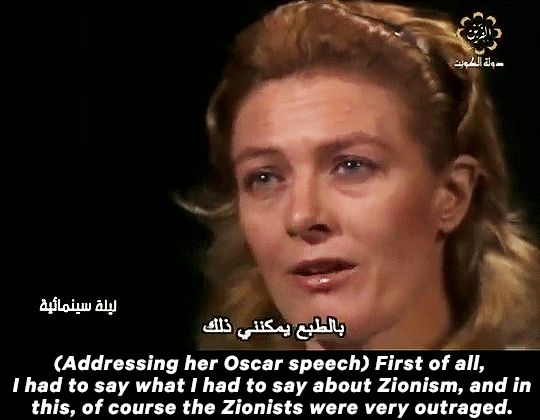





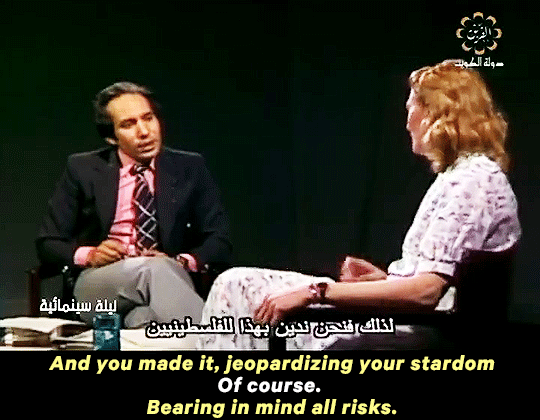
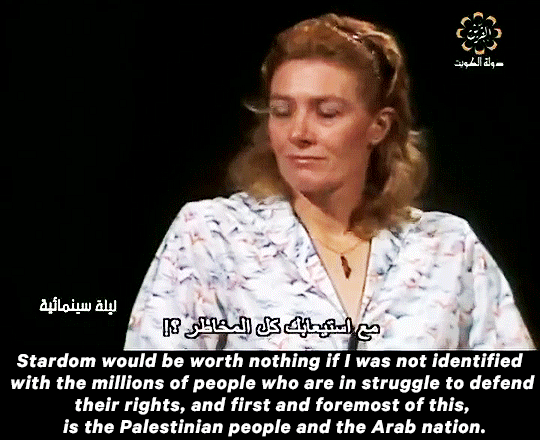
Vanessa Redgrave's on Palestine, her Oscars speech, and The Palestinian (1977)
Links:
this interview
1978 Best Supporting Actress (Julia) win and speech
The Palestinian (1977)
and here she is in 2008 NYC Ethical Culture speaking for Palestine
#vanessa redgrave#palestine#free palestine#academy awards#the palestinian 1977#gifs#i just wanted to correct the aspect ratio it was bothering me sdkjfhdskf#zionism is a danger against all people all over the world. wow spilled#the palestinization of the world#zionism#oscars 1978#ok i love this mixed media option now btw. good job on that tumblr#i forgot she was also able to insert the huac and mccarthyism at the end of her speech wow#huac#mccarthyism
619 notes
·
View notes
Text
Hey check this out
I was making a zine (solarpunk ofc) and decided to use a bunch of old National Geographic magazines to cut up and use in a scrappy diy scrapbook fashion and of course I started reading them. This one in particular:

It caught my eye because it’s from September 1980 & talks about the Middle East. My brain wonders if they mention Palestine and they do! I copied the text for accessibility, but I put pictures at the end of the original pages.
“Jerusalem: reunited or occupied? The question has divided the city's 400,000 Jews and 100,000 Arabs since Israel annexed East Jerusalem in 1967.
BEIRUT, JANUARY 1975. Armed soldiers lead me through labyrinthine back streets, up a dark stairway to a midnight rendez-vous. Only a bare bulb lights the temporary command post; Yasir Arafat, chairman of the Palestine Liberation Organization, seldom dares spend two days in the same place. “Our argument is not with the Jews” He tells me. "We are both Semites. They have lived with us for centuries. Our enemies are the Zionist colonizers and their backers who insist Palestine belongs to them exclusively.
We Arabs claim deep roots there too."
Two decades ago Palestinians were to be found in United Nations Relief Agency camps at places like Gaza and Jericho, in a forlorn and pitiable state. While Palestinian spokesmen pressed their case in world cap-itals, the loudest voice the world heard was that of terrorists, with whom the word Palestinian came to be associated. Jordan fought a war to curb them. The disintegration of Lebanon was due in part to the thousands of refugees within its borders.
Prospects for peace brightened, however, when President Anwar Sadat of Egypt, most powerful of the Arab countries, made his historic trip to Israel in November 1977. A year later Sadat and Israeli Prime Minister Menachem Begin signed the Camp David accords, a framework for the return of the occupied Sinai Peninsula to Egypt.
The former enemies established diplomatic relations and opened mail, telephone, and airline communications.
The Camp David accords also addressed the all-important Palestinian question but left it vague. Sadat insists that any lasting peace depends on an eventual Palestinian homeland in the Israeli-occupied West Bank and Gaza. Israel agrees to limited autonomy for those regions, but, fearful of a new and hostile Palestinian state suddenly planted on its borders, insists that Israeli troops must maintain security there.
Crowded Rashidiyah refugee camp, set among orange groves south of the ancient Phoenician port of Tyre in Lebanon, lies on the front lines. Frequent pounding by Israeli military jets and warships seeking PLO targets has war-hardened its population, some 13,700 Palestinians.
At the schoolyard I watched a solemn flag raising. Uniformed ashbal, or lion cubs, stood rigid as color guards briskly ran up the green-white-and-black Palestinian flag.
Ranging in age from 8 to 12, they might have been Cub Scouts— except for the loaded rifles they held at present arms. Behind them stood two rows of girls, zaharat, or little flowers. Same age, same weapons.
Over lunch of flat bread, hummus, yo-gurt, and chicken I commented to my hosts, a group of combat-ready fedayeen, that 30 years of bitter war had settled nothing nor gained the Palestinians one inch of their homeland. Was there no peaceful way to press their cause?
"Yes, and we are doing it. Finally, after 30 years, most countries in the United Nations recognize that we too have rights in Palestine. But we feel that until your country stops its unconditional aid to Israel, we have two choices: to fight, or to face an unmarked grave in exile."
AFTER CROSSING the Allenby Bridge from Amman, I drove across the fertile Jordan Valley through Arab Jericho and past some of the controversial new Jewish settlements: Mitzpe Jericho, Tomer, Maale Adumim, Shilat. Then as I climbed through the steep stony hills to Jerusalem, I saw that it too had changed. A ring of high-rise apartments and offices was growing inexorably around the occupied Arab side of the walled town. Within the wall, too, scores of Arab houses had been leveled during extensive reconstruction.
"Already 64 settlements have been built on the West Bank," said a Christian Palestinian agriculturist working for an American church group in Jerusalem. "And another 10 are planned," he said. Unfolding a copy of the master plan prepared in 1978 by the World Zionist Organization, he read: "Real-izing our right to Eretz-Israel... with or without peace, we will have to learn to live with the minorities...
The Israeli Government has reaffirmed the policy. In Prime Minister Menachem Begin's words: "Settlement is an inherent and inalienable right. It is an integral part of our national security."
"Security" is a word deeply etched into the Israeli psyche. The country has lived for 30 years as an armed camp, always on guard against PLO raids and terrorist bombings.
Whenever such incidents occur, the response is quick: even greater retaliation.
In Jerusalem I met with David Eppel, an English-language broadcaster for the Voice of Israel. "We must continue to build this country. Israel is our lawful home, our des-tiny. We have the determination, and an immense pool of talent, to see it through." His cosmopolitan friends a city plan-ner, a psychology professor, an author gathered for coffee and conversation at David's modern apartment on Jerusalem's Leib Yaffe Road.
Amia Lieblich's book, Tin Soldiers on Jerusalem Beach, studies the debilitating effects almost constant war has had on life in the Jewish state, a nation still surrounded by enemies. As she and her husband kindly drove me to my hotel in Arab Jerusalem afterward, some of that national apprehension surfaced in the writer herself.
"We don't often come over to this part of town," she said. "Especially at night."
I DROVE OUT of the Old City in the dark of morning and arrived a few hours later at the nearly finished Israeli frontier post, whence a shuttle bus bounced me through no-man's-land to the Egyptian ter-minal. As a result of the Egyptian-Israeli treaty, it was possible for the first time since 1948 to travel overland from Jerusalem to Cairo. An Egyptian customs man opened my bags on a card table set up in the sand. I took a battered taxi into nearby El Arish, to a sleepy bank that took 45 minutes to convert dollars into Egyptian pounds, Then 1 hired a Mercedes for the
200-mile run across the northern Sinai des-ert, the Suez Canal, and the Nile Delta. By sundown Cairo was mine.
Despite official government optimism, I found many in Cairo worried that President Sadat's bold diplomatic gestures might fail.
The city was noticeably tense as Israel officially opened its new embassy on Mohi el-Din Abu el-Ez Street in Cairo's Dukki quarter. Black-uniformed Egyptian troops guarded the chancery and nearby intersections as the Star of David flew for the first time in an Arab capital. Across town, police with fixed bayonets were posted every ten feet around the American Embassy. Others were posted at the TV station and the larger hotels. Protests were scattered, mostly peaceful. None disturbed the cadence of the city.
Welcoming ever larger delegations of tourists and businessmen from Europe and the U.S., Cairo was busier than ever-and more crowded. Despite a building boom, many Egyptians migrating from the countryside, perhaps 10,000 a month, still find housing only by squatting among tombs at the City of the Dead, the huge old cemetery on the southeast side of the capital.
Even with the new elevated highway and wider bridge across the Nile, half-hour traffic standstills are common. Commuters arrive at Ramses Station riding even the roofs of trains, then cram buses until axles break.
Cairo smog, a corrosive blend of diesel fumes and hot dust from surrounding des-erts, rivals tear gas.
Despite the rampant blessings of prog-ress, Cairo can still charm. In the medieval Khan el-Khalili bazaar near Cairo's thousand-year-old Al-Azhar University, I sought out Ahmad Saadullah's sidewalk café. I found that 30 piasters (45 cents) still brings hot tea, a tall water pipe primed with tobacco and glowing charcoal, and the latest gossip. The turbaned gentleman on the carpeted bench opposite was unusually talk-ative; we dispensed with weather and the high cost of living and got right to politics:
"Of course I am behind President Sadat, but he is taking a great risk. The Israelis have not fully responded. If Sadat fails, no other Arab leader will dare try for peace again for a generation."
Across town at the weekly Akhbar El-Yom newspaper, one of the largest and most widely read in the Middle East, chief editor Abdel-Hamid Abdel-Ghani drove home that same point.
"What worries me most is that President Sadat's agreement with Israel has isolated Egypt from our brother nations," he told me. "When Saudi Arabia broke with us, it was a heavy loss. The Saudis are our close neighbors. Now they have canceled pledges for hundreds of millions in development aid to Egypt. Some 200,000 Egyptians-teach-ers, doctors, engineers live and work in the kingdom.
"And Saudi Arabia, guardian of the holy cities of Mecca and Medina, remains for Muslim Egypt a spiritual homeland."
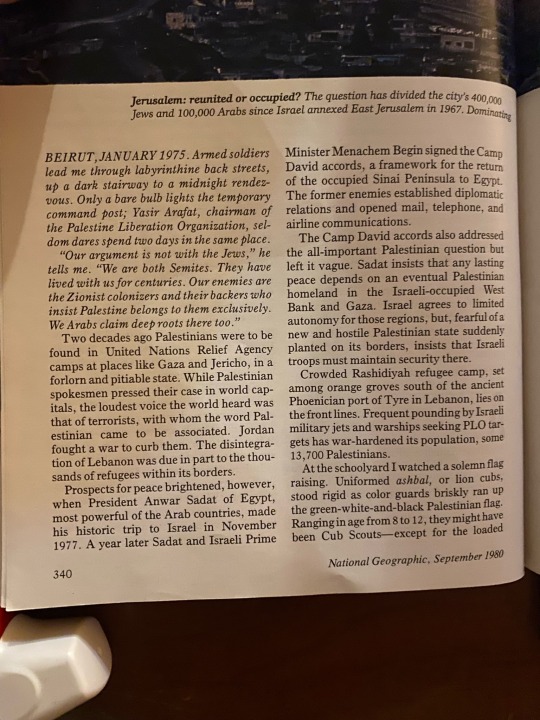

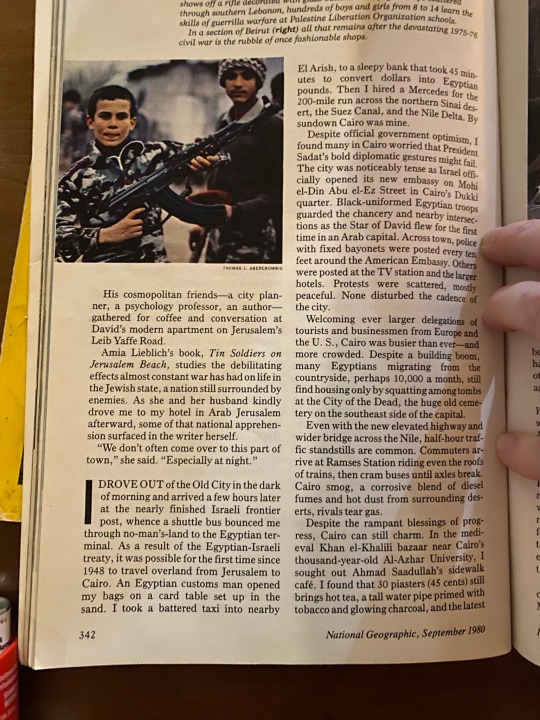
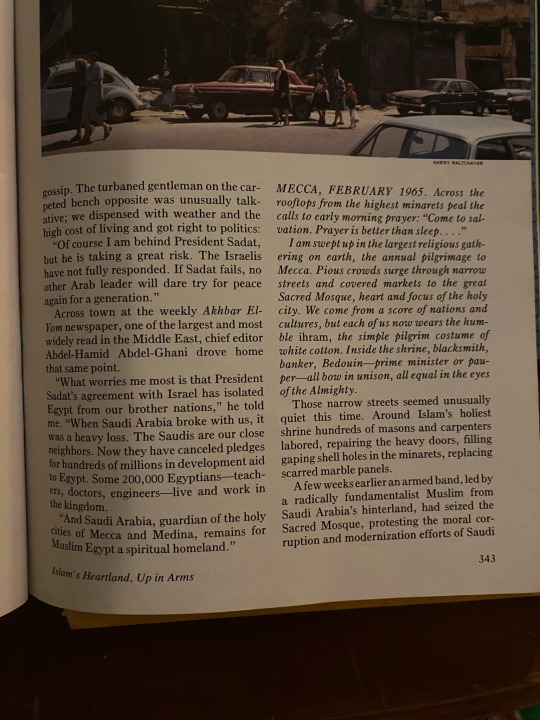
This magazine was published before my mom was born, and yet the sentiments have basically unchanged. An interesting look at the past, and more proof this didn’t start October 7th. (But imagine my followers already knew that)
#Palestine#free palestine#from the river to the sea palestine will be free#national geographic#September 1980
52 notes
·
View notes
Text

Unknown. General Strike in Egypt. 1977.
Translation / Caption Text
Arabic translation:
The Palestinian revolution salutes the mass strike on January 18 and 19 in Egypt (1977)
46 notes
·
View notes
Text

The milkmaid, 2007 - by Raeda Saadeh (1977), Palestinian
66 notes
·
View notes
Text
In the late 1960s and early ’70s the Black Consciousness Movement, a grassroots anti-apartheid movement, also expressed support for the Palestinian struggle. So too did one of Africa’s greatest independence heroes, Amílcar Cabral, who said: ‘We stand with the Palestinian refugees and support everything that the children of Palestine do in order to free their country, and… the Arab and African countries do to aid the Palestinian people to recover its dignity, its independence and its right to life.’
South Africans recognise Israel’s culpability in their own historic oppression. In the 1970s, this extended to the field of nuclear weaponry – Israeli experts helped South Africa develop at least six nuclear warheads. In 1977, after the murder of anti-apartheid activist Steve Biko by South African security police, the UN imposed a mandatory arms embargo on the country. And by the 1980s the global anti-apartheid movement forced states to impose sanctions.
But as late as 1980, 35 per cent of Israel’s arms exports were destined for South Africa and, in the same decade, Israel imported South African goods and re-exported them to the world as a form of inter-racist solidarity. Meanwhile Israeli companies subsidised by the apartheid regime were established in a number of bantustans, all the while paying workers a pittance.
58 notes
·
View notes